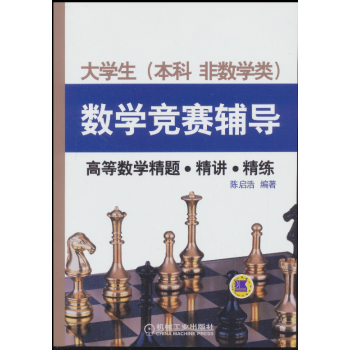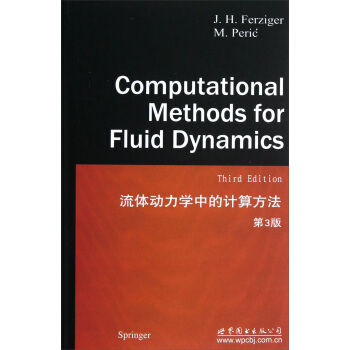

具体描述
内容简介
弗兹格编著的《流体动力学中的计算方法(第3版)》内容介绍:Computational fluid dynamics, commonly known by the acronym‘CFD’,is undergoing significant expansion in terms of both the number of courses offered at universities and the number of researchers active in the field. There are a number of software packages available that solve fluid flow problems; the market is not quite as large as the one for structural mechanics codes, in which finite element methods are well established. The lag can be explained by the [act that CFD problems are, in general, more difficult to solve. However, CFD codes are slowly being accepted as design tools by industrial users. At present,users of CFD need to be fairly knowledgeable, which requires education of both students and working engineers. The present book is an attempt to fill this need.目录
Preface1.Basic Concepts of Fluid Flow
1.1 Introduction
1.2 Conservation Principles
1.3 Mass Conservation
1.4 Momentum Conservation
1.5 Conservation of Scalar Quantities
1.6 Dimensionless Form of Equations
1.7 Simplified Mathematical Models
1.7.1 Incompressible Flow
1.7.2 Inviscid (Euler) Flow
1.7.3 Potential Flow
1.7.4 Creeping (Stokes) Flow
1.7.5 Boussinesq Approximation
1.7.6 Boundary Layer Approximation
1.7.7 Modeling of Complex Flow Phenomena
1.8 Mathematical Classification of Flows
1.8.1 Hyperbolic Plows
1.8.2 Parabolic Flows
1.8.3 Elliptic Flows
1.8.4 Mixed Flow Types
1.9 Plan of This Book
2.Introduction to Numerical Methods
2.1 Approaches to Fluid Dynamical Problems
2.2 What is CFD?
2.3 Possibilities and Limitations of Numerical Methods
2.4 Components of a Numerical Solution Method
2.4.1 Mathematical Model
2.4.2 Discretization Method
2.4.3 Coordinate and Basis Vector Systems
2.4.4 Numerical Grid
2.4.5 Finite Approximations
2.4.6 Solution Method
2.4.7 Convergence Criteria
2.5 Properties of Numerical Solution Methods
2.5.1 Consistency
2.5.2 Stability
2.5.3 Convergence
2.5.4 Conservation
2.5.5 Boundedness
2.5.6 Realizability
2.5.7 Accuracy
2.6 Discretization Approaches
2.6.1 Finite Difference Method
2.6.2 Finite Volume Method
2.6.3 Finite Element Method
3.Finite Difference Methods
3.1 Introduction
3.2 Basic Concept
3.3 Approximation of the First Derivative
3.3.1 Taylor Series Expansion
3.3.2 Polynomial Fitting
3.3.3 Compact Schemes
3.3.4 Non-Uniform Grids
3.4 Approximation of the Second Derivative
3.5 Approximation of Mixed Derivatives
3.6 Approximation of Other Terms
3.7 Implementation of Boundary Conditions
3.8 The Algebraic Equation System
3.9 Discretization Errors
3.10 An Introduction to Spectral Methods
3.10.1 Basic Concept
3.10.2 Another View of Discretization Error
3.11 Example
4.Finite Volume Methods
4.1 Introduction
4.2 Approximation of Surface Integrals
4.3 Approximation of Volume Integrals
4.4 Interpolation and Differentiation Practices
4.4.1 Upwind Interpolation (UDS)
4.4.2 Linear Interpolation (CDS)
4.4.3 Quadratic Upwind Interpolation (QUICK)..
4.4.4 Higher-Order Schemes
4.4.5 Other Schemes
4.5 Implementation of Boundary Conditions
4.6 The Algebraic Equation System
4.7 Examples
Solution of Linear Equation Systems
5.1 Introduction
5.2 Direct Methods
5.2.1 Gauss Elimination
5.2.2 LU Decomposition
5.2.3 Tridiagonal Systems
5.2.4 Cyclic Reduction
5.3 Iterative Methods
5.3.1 Basic Concept
5.3.2 Convergence
5.3.3 Some Basic Methods
5.3.4 Incomplete LU Decomposition: Stone's Method
5.3.5 ADI and Other Splitting Methods
5.3.6 Conjugate Gradient Methods
5.3.7 Biconjugate Gradients and CGSTAB
5.3.8 Multigrid Methods
5.3.9 Other Iterative Solvers
5.4 Coupled Equations and Their Solution
5.4.1 Simultaneous Solution
5.4.2 Sequential Solution
5.4.3 Under-Relaxation
5.5 Non-Linear Equations and their Solution
5.5.1 Newton-like Techniques
5.5.2 Other Techniques
5.6 Deferred-Correction Approaches
5.7 Convergence Criteria and Iteration Errors
5.8 Examples
Methods for Unsteady Problems
6.1 Introduction
6.2 Methods for Initial Value Problems in ODEs
6.2.1 Two-Level Methods
6.2.2 Predictor-Corrector and Multipoint Methods
6.2.3 Runge-Kutta Methods
6.2.4 Other Methods
6.3 Application to the Generic Transport Equation
6.3.1 Explicit Methods
6.3.2 Implicit Methods
6.3.3 Other Methods
5.4 Examples
7.Solution of the Navier-Stokes Equations
7.1 Special Features of the Navier-Stokes Equations
7.1.1 Discretization of Convective and Viscous Terms
7.1.2 Discretization of Pressure Terms and Body Forces
7.1.3 Conservation Properties
7.2 Choice of Variable Arrangement on the Grid
7.2.1 Colocated Arrangement
7.2.2 Staggered Arrangements
7.3 Calculation of the Pressure
7.3.1 The Pressure Equation and its Solution
7.3.2 A Simple Explicit Time Advance Scheme
7.3.3 A Simple Implicit Time Advance Method
7.3.4 Implicit Pressure-Correction Methods
7.4 Other Methods
7.4.1 Fractional Step Methods
7.4.2 Streamfunction-Vorticity Methods
7.4.3 Artificial Compressibility Methods
7.5 Solution Methods for the Navier-Stokes Equations
7.5.1 Implicit Scheme Using Pressure-Correction and a Stag-
gered Grid
7.5.2 Treatment of Pressure for Colocated Variables
7.5.3 SIMPLE Algorithm for a Colocated Variable Arrange-
ment
7.6 Note on Pressure and Incompressibility
7.7 Boundary Conditions for the Navier-Stokes Equations
7.8 Examples
8.Complex Geometries
8.1 The Choice of Grid
8.1.1 Stepwise Approximation Using Regular Grids
8.1.2 Overlapping Grids
8.1.3 Boundary-Fitted Non-Orthogonal Grids
8.2 Grid Generation
8.3 The Choice of Velocity Components
8.3.1 Grid-Oriented Velocity Components
8.3.2 Cartesian Velocity Components
8.4 The Choice of Variable Arrangement
8.4.1 Staggered Arrangements
8.4.2 Colocated Arrangement
8.5 Finite Difference Methods
8.5.1 Methods Based on Coordinate Transformation
8.5.2 Method Based on Shape Functions
8.6 Finite Volume Methods
8.6.1 Approximation of Convective Fluxes
8.6.2 Approximation of Diffusive Fluxes
8.6.3 Approximation of Source Terms
8.6.4 Three-Dimensional Grids
8.6.5 Block-Structured Grids
8.6.6 Unstructured Grids
8.7 Control-Volume-Based Finite Element Methods
8.8 Pressure-Correction Equation
8.9 Axi-Symmetric Problems
8.10 Implementation of Boundary Conditions
8.10.1 Inlet
8.10.2 Outlet
8.10.3 Impermeable Walls
8.10.4 Symmetry Planes
8.10.5 Specified Pressure
8.11 Examples
9.Turbulent Flows
9.1 Introduction
9.2 Direct Numerical Simulation (DNS)
9.2.1 Example: Spatial Decay of Grid Turbulence
9.3 Large Eddy Simulation (LES)
9.3.1 Smagorinsky and Related Models
9.3.2 Dynamic Models
9.3.3 Deconvolution Models
9.3.4 Example: Flow Over a Wall-Mounted Cube
9.3.5 Example: Stratified Homogeneous Shear Flow
9.4 RANS Models
9.4.1 Reynolds-Averaged Navier-Stokes (RANS) Equations
9.4.2 Simple Turbulence Models and their Application
9.4.3 The v2f Model
9.4.4 Example: Flow Around an Engine Valve
9.5 Reynolds Stress Models
9.6 Very Large Eddy Simulation
10. Compressible Flow
10.1 Introduction
10.2 Pressure-Correction Methods for Arbitrary Mach Number
10.2.1 Pressure-Velocity-Density Coupling
10.2.2 Boundary Conditions
10.2.3 Examples
10.3 Methods Designed for Compressible Flow
10.3.1 An Overview of Some Specific Methods
11. Efficiency and Accuracy Improvement
11.1 Error Analysis and Estimation
11.1.1 Description of Errors
11.1.2 Estimation of Errors
11.1.3 Recommended Practice for CFD Uncertainty Analysis
11.2 Grid quality and optimization
11.3 Multigrid Methods for Flow Calculation
11.4 Adaptive Grid Methods and Local Grid Refinement
11.5 Parallel Computing in CFD
11.5.1 Iterative Schemes for Linear Equations
11.5.2 Domain Decomposition in Space
11.5.3 Domain Decomposition in Time
11.5.4 Efficiency of Parallel Computing
12. Special Topics
12.1 Introduction
12.2 Heat and Mass Transfer
12.3 Flows With Variable Fluid Properties
12.4 Moving Grids
12.5 Free-Surface Flows
12.5.1 Interface-Tracking Methods
12.5.2 Hybrid Methods
12.6 Meteorological and Oceanographic Applications
12.7 Multiphase flows
12.8 Combustion
A. Appendices
A.1 List of Computer Codes and How to Access Them
A.2 List of Frequently Used Abbreviations
References
Index
前言/序言
用户评价
说实话,我本来对流体动力学计算方法这类枯燥的书籍没有抱太大希望,但这本书彻底改变了我的看法。它没有用那些晦涩难懂的语言来堆砌公式,而是用一种非常生动有趣的方式来讲解。作者的叙述风格很吸引人,仿佛在和你讲一个精彩的故事。他会用一些生动的比喻来解释抽象的概念,比如把数值网格比作给流体“拍照”的像素点,把离散误差比作“失焦”的效果。而且,书中穿插了大量的实际工程案例,从飞机翼型的设计到汽车尾翼的优化,都展示了CFD强大的应用能力,这让我对这门学科产生了浓厚的兴趣。最让我印象深刻的是,作者在讲解一些关键算法时,不仅仅给出公式,还会画出流程图,甚至给出伪代码,这对于我这种动手能力比较强的人来说,简直是太实用了。读完这本书,我不仅学到了知识,更重要的是激发了我学习的动力和热情。
评分这本书的内容密度很高,可以说是知识的宝库。我之前接触过一些流体动力学方面的教材,但都没有这本书这么全面和系统。它涵盖了从经典算法到前沿技术的方方面面,几乎无所不包。我对书中关于隐式和显式时间推进方法的比较分析印象深刻,这有助于我更好地理解不同方法的效率和稳定性。此外,书中对求解器算法的讲解,包括迭代法和直接法的选择,以及预条件子的使用,都非常有价值。我特别欣赏作者在处理一些难点问题时的细致和耐心,比如如何处理奇点、如何平衡计算精度和效率等。这本书给我最大的感受是,它不仅仅是一本“怎么做”的书,更是一本“为什么这么做”的书。它能够帮助我建立起一套完整的CFD知识体系,让我能够独立思考和解决实际问题。这本书是我在流体动力学计算领域学习和研究的宝贵财富。
评分从一名在实际工程中饱受CFD应用困扰的工程师角度来看,这本书无疑是救星一般的存在。我常常在模拟中遇到各种奇怪的问题,比如结果不收敛、物理现象失真,或者不知道如何选择合适的模型。而这本书,就像是给了我一个“解剖”这些问题的工具箱。它没有回避那些复杂的数学细节,而是用一种非常实用主义的方式,将理论与实践紧密结合。书中对离散化误差的分析,对稳定性条件的讲解,以及不同数值通量格式的选择,都给了我极大的启发。尤其是在处理激波、湍流等复杂流动现象时,作者的讲解让我茅塞顿开,明白了为什么某些方法在特定情况下会失效,以及如何根据实际需求进行调整。这本书的价值在于它教会我“思考”CFD,而不是简单地“操作”CFD。我学会了如何更审慎地选择离散格式,如何更有效地进行网格划分,以及如何更明智地解读和验证模拟结果。这本书让我从一个CFD的“使用者”变成了一个“理解者”,甚至是一个“使用者”。
评分作为一名对理论基础有着严谨追求的研究生,我一直认为一本好的教材应该能够兼顾深度和广度。这本书在这方面做得非常出色。它从最基础的 Navier-Stokes 方程推导开始,一步一步引导读者深入理解有限体积法的核心思想,包括守恒律的离散化,通量计算的各种方法,以及时间积分的策略。书中的数学推导严谨而清晰,让我能够追踪每一个公式的来源,理解其物理意义。我尤其喜欢书中关于守恒性和一致性概念的阐述,这对于保证数值解的可靠性至关重要。此外,它还涉及了许多高级主题,比如多相流、可压缩流动的数值方法,甚至还触及了关于并行计算和高性能计算的一些初步介绍,这为我今后的研究方向提供了宝贵的参考。虽然有些章节的阅读需要花费大量时间,但每一次的钻研都让我感觉自己的理论功底更加扎实。这本书不仅是一次知识的积累,更是一次思维的训练。
评分这本书简直是流体动力学计算领域的圣经!我花了整整一个周末沉浸其中,感觉大脑被彻底洗礼了一番。初学者可能一开始会觉得有点门槛,但如果你真的想深入理解CFD的精髓,这本书绝对是绕不开的。它不仅仅是罗列公式和算法,更重要的是解释了这些方法背后的物理原理和数学推导,让你明白为什么这么做,而不是死记硬背。书中对不同数值方法的优缺点分析得非常透彻,从有限差分到有限体积再到有限元,每一种方法都循序渐进地讲解,并且配以大量的图示和例子,这对于我这种视觉型学习者来说简直是福音。我特别欣赏作者在讲解边界条件处理时那种细致入微的描述,以及对网格生成和收敛性分析的深入探讨。读完之后,我感觉自己对CFD的理解上升了一个全新的高度,不再是停留在“会用软件”的层面,而是真正理解了“软件背后的科学”。虽然有些地方需要反复琢磨,但每一次的豁然开朗都让人无比欣喜。这本书的价值,远不止于一本教材,它更像是一位循循善诱的导师,引领我探索计算流体力学的广阔天地。
评分好 很好的东西 希望下次还能来买
评分好 很好的东西 希望下次还能来买
评分可以,希望有用
评分书质量还不错
评分自学用书,书到手完整没有破损,希望能有所收货吧
评分融教学参考于一体的书,比较专业,值得一看
评分老师推荐的图书,值得购买。这是一本比较基础友好的图书
评分peric的计算流体力学也是很经典,这个感觉很tiny呀
评分字好小啊?~看起来很费劲吧
相关图书
本站所有内容均为互联网搜索引擎提供的公开搜索信息,本站不存储任何数据与内容,任何内容与数据均与本站无关,如有需要请联系相关搜索引擎包括但不限于百度,google,bing,sogou 等
© 2026 book.tinynews.org All Rights Reserved. 静思书屋 版权所有


![测度论引论(英文版) [An Introduction to Measure Theory] pdf epub mobi 电子书 下载](https://pic.tinynews.org/12118834/58b61ef0N0d1b4f95.jpg)
![数学名著译丛·数学:它的内容、方法和意义(第1卷) [Mathematics,Its Essence,Method,and Role] pdf epub mobi 电子书 下载](https://pic.tinynews.org/11228780/rBEQYVGUUT0IAAAAAAfIid0fUuEAABRvwFTzfoAB8ih401.jpg)

![弹性理论(第3版) [Theory of EIasticity] pdf epub mobi 电子书 下载](https://pic.tinynews.org/11255809/5642d940N0f780c1e.jpg)
![金融数学引论(英文版) [Introduction to the Mathematics of Finance] pdf epub mobi 电子书 下载](https://pic.tinynews.org/12038123/58b61ef0N88b9399c.jpg)
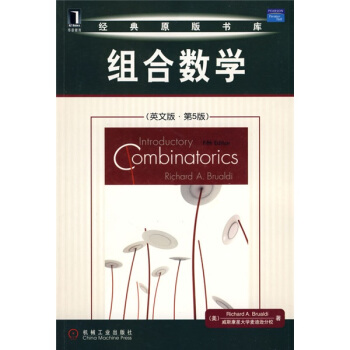

![地理信息系统导论(原著第5版) [Introduction?to?Geographic?Information?Systems] pdf epub mobi 电子书 下载](https://pic.tinynews.org/10003442/687b3551-4c07-435e-b9c1-a46dde7055d0.jpg)

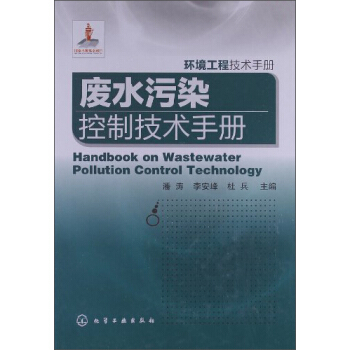
![ε空间 I:实分析(第三年的数学博客选文)(英文版) [An Epsilon of Room,I:Real Analysis(Pages from year three of a Mathematical Blog)] pdf epub mobi 电子书 下载](https://pic.tinynews.org/12118828/58b391f9N68bdcf84.jpg)

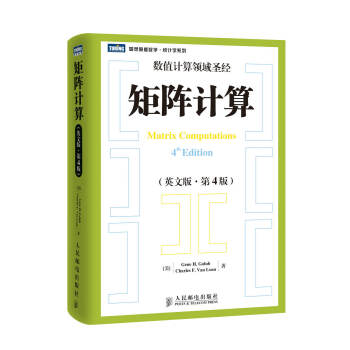
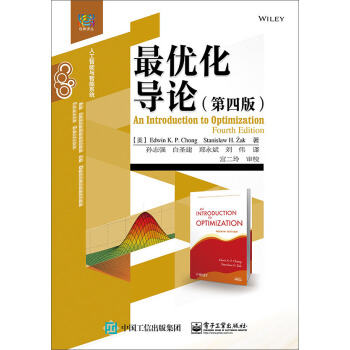
![极小曲面教程(英文版) [A Course in Minimal Surfaces] pdf epub mobi 电子书 下载](https://pic.tinynews.org/12038119/58b7eec4N7b8317f1.jpg)


